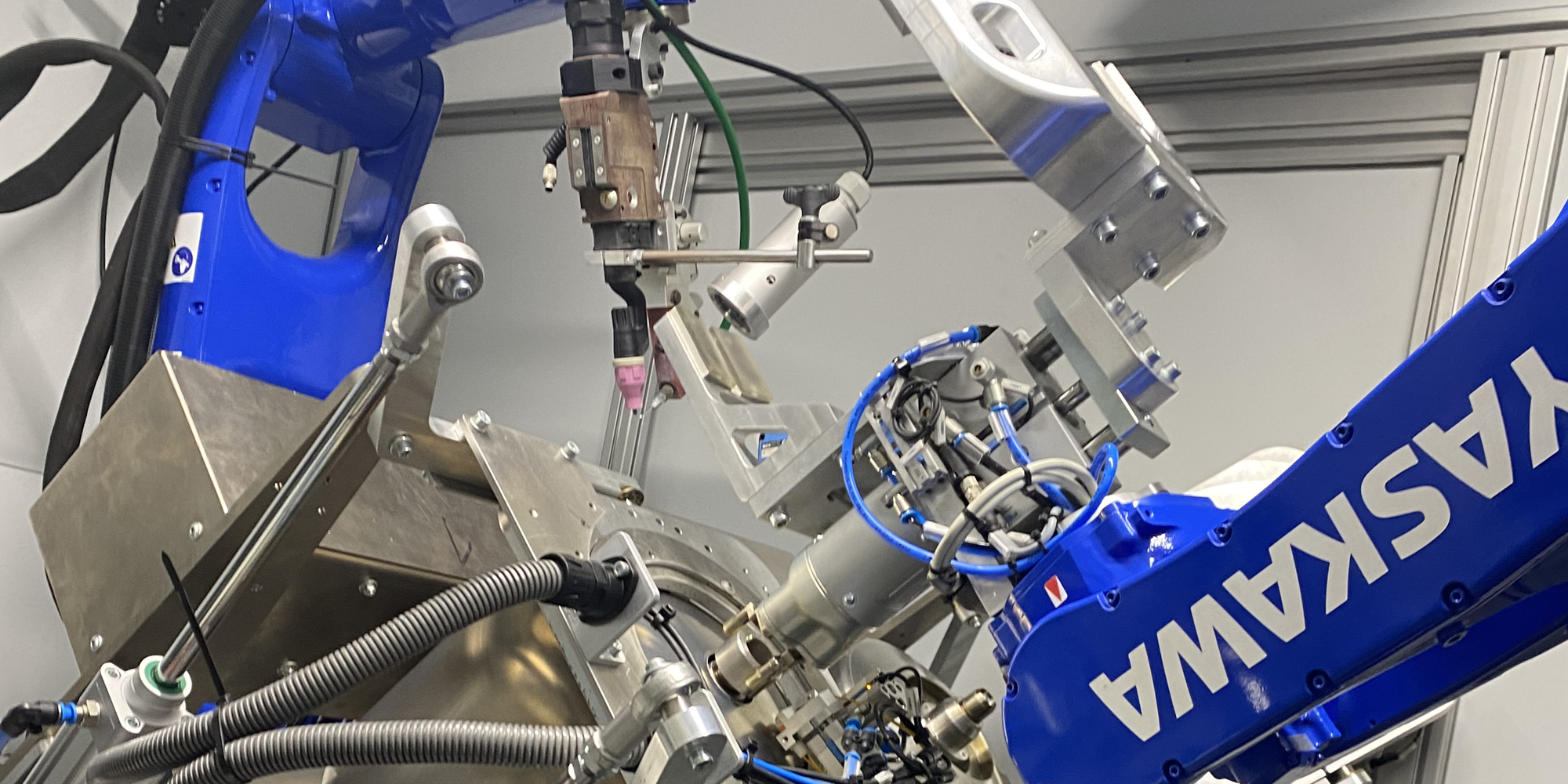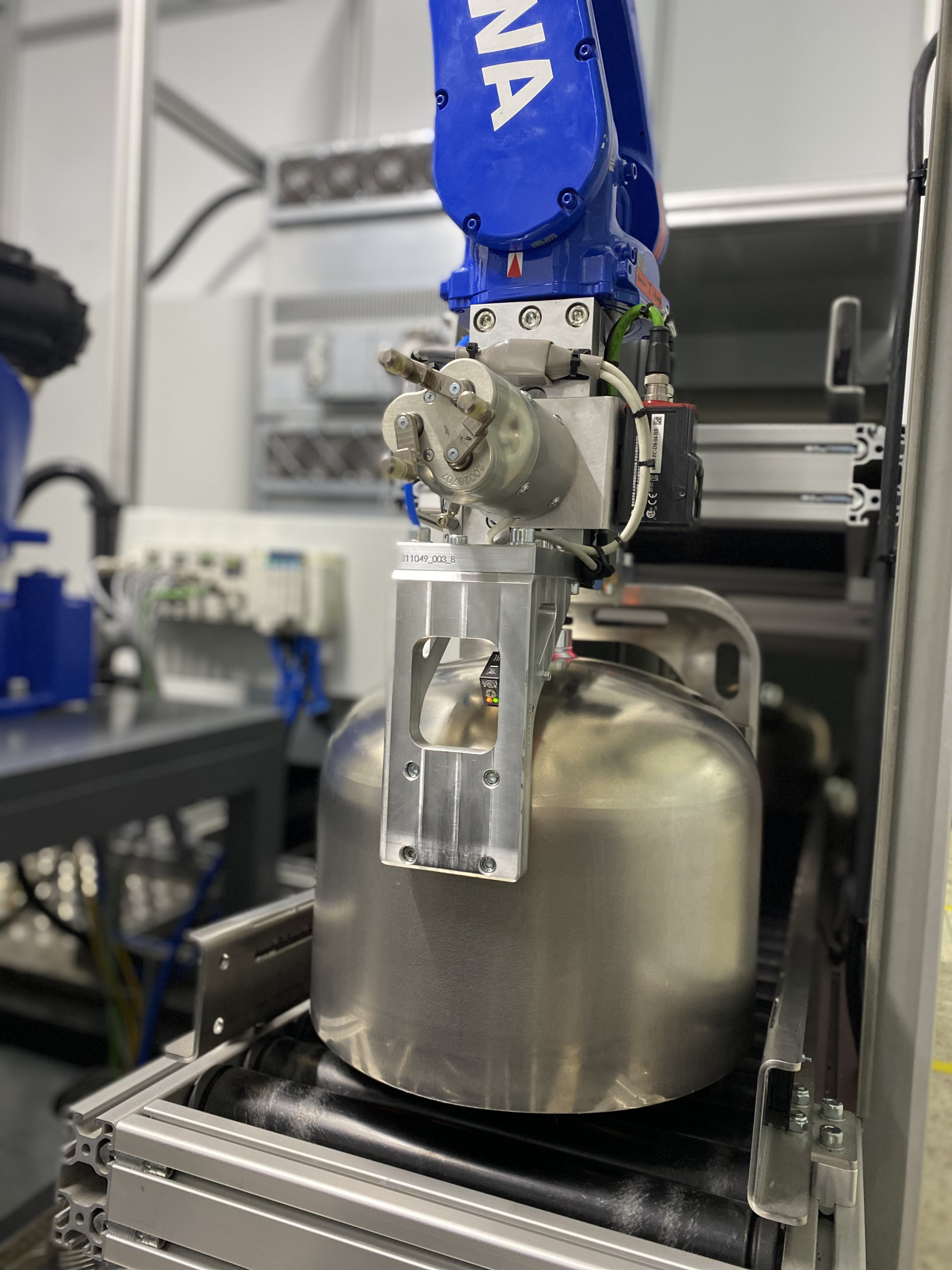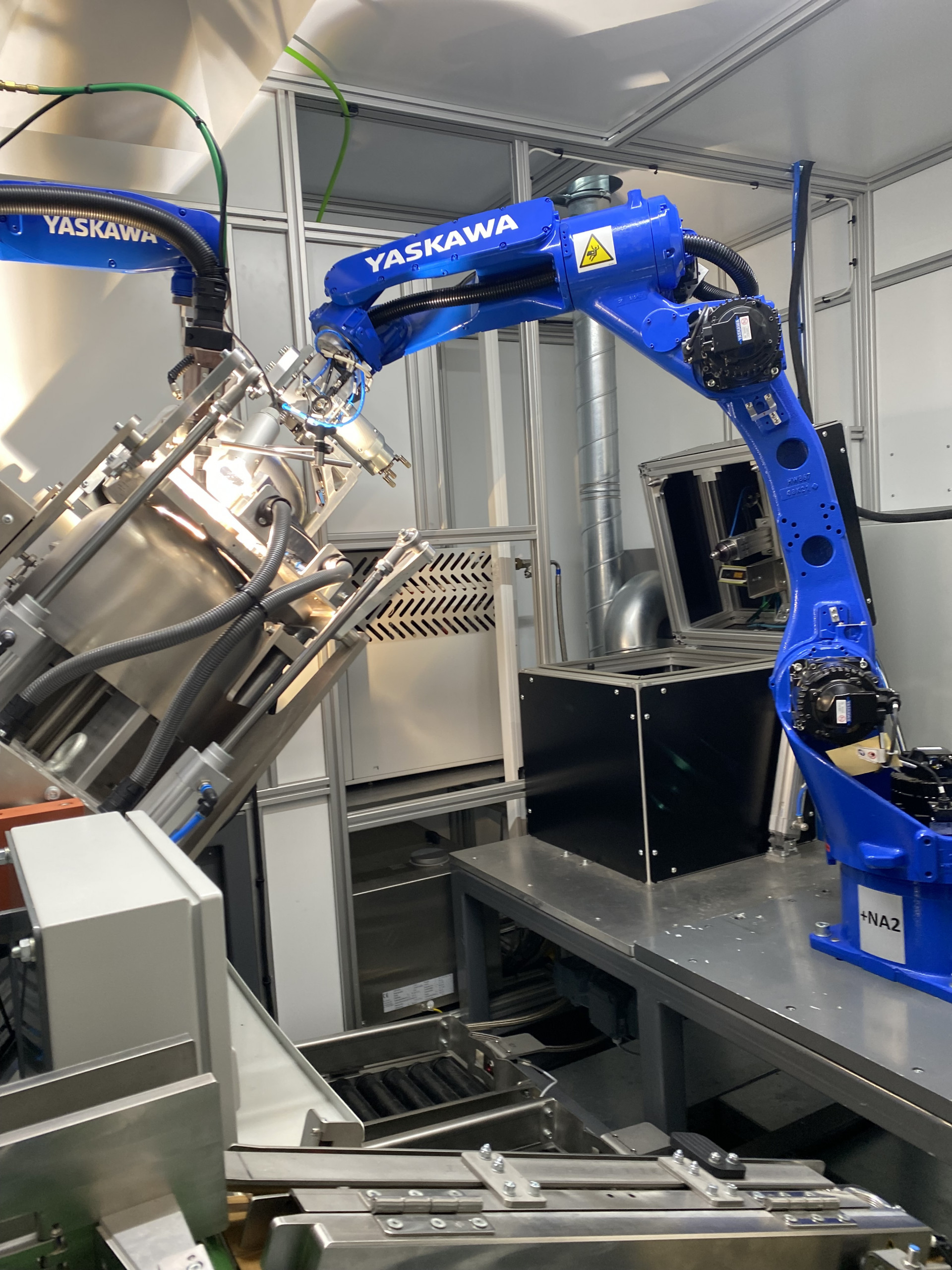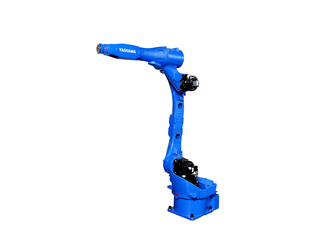
Valve sleeves are a key element in gas cylinders: they enable regulators and fittings to be connected to the cylinder safely and gas-tight. At Alugas, around 1000 joints are welded every day – recently fully automated. System builder Roland Ruegenberg from Bad Sobernheim has designed a system with two Motoman industrial robots from Yaskawa at its heart. They literally work “arm in arm” and take over both the complete parts handling and the welding process.
Alugas wants nothing less than to “make life easier” for its customers. And this is to be understood quite literally: Campers and barbecue masters swear by their pressure tanks for liquefied gases such as propane and butane (LPG), as do forklift drivers and tradesmen. This is because the high-tech gas cylinders from Bad Sobernheim are up to 50 percent lighter than conventional steel cylinders, making them ideal for mobile use, both at work and in the sports and leisure sector.
A welding cell for the supreme discipline

© Roland Ruegenberg GmbH
The valve sleeves are an important element of gas cylinders. They fulfill central functions in terms of security and connectivity. Alugas currently combines four sleeve models with three different sized half-shells, thus offering a wide range of cylinders for all applications.
Previously, the sockets were welded onto the half shells in a semi-automatic system. However, this had become outdated and no longer met the state of the art and the increased requirements. A new welding solution was therefore required – and not an “off-the-shelf” one. This is because aluminum has special properties and behaviors, including very high thermal conductivity. This requires more specialized processes than the processing of other metals such as steel.
TIG cold wire welding (TIG = tungsten inert gas) is ideal for welding aluminum. It allows very precise control over the heat input and is ideal for applications where high precision and clean weld seams are important. However: “TIG cold wire welding is the ultimate discipline in aluminum welding and requires precise temperature control of the workpieces,” explains Dominik Sperling, project engineer at system builder Roland Ruegenberg GmbH. Alugas turned to this company in its search for a partner to redesign and build its customized welding cell.
Customer requirement: A compact system suitable for sea containers
In addition to the various half-shell and socket combinations, Alugas had other requirements: It had to be possible to expand the portfolio. And in order to be able to maintain the existing production processes, an autonomy time of 30 minutes had to be observed.
Another important requirement was that the system should be suitable for sea containers. “There were two reasons for this: Firstly, Alugas was planning a new site overseas, which was to have the same system as the main plant. Secondly, the plant at the German site had to be able to be relocated without a great deal of effort; we had to take into account that some passages are very narrow,” reports Dominik Sperling. Ruegenberg specializes in precisely such challenges in the development of fully automated production systems: “We find solutions for seemingly unsolvable tasks,” is the company’s high claim.
Ruegenberg developed an amazingly compact system. It not only contains two welding fixtures with a preheating function; the pre-process of laser marking the sockets and the downstream testing could also be integrated. Nevertheless, the system is designed in such a way that the individual modules can be easily separated and reassembled – and therefore fit easily into a sea container. It is thanks to two Yaskawa Motoman industrial robots that all processes can be mapped on an area of just 3 m by 5 m. These take over the entire component handling and welding process: “All relevant handling processes are carried out in parallel with the individual welding processes. This means that the processes are optimally utilized,” explains Sperling.
The system is fed manually – for the half shells, which weigh around 2 kg, via roller conveyors, and for the sleeves via a feed conveyor with buffer. They are automatically separated, the sleeves are then marked with a DMC code by an integrated laser and brought to the required preheating temperature on a temperature-controlled accumulation section. During the fully automatic welding process, a Yaskawa AR900 welding robot takes over the torch control.
The half-shell, now fitted with a sleeve, is then transferred to a geometry inspection station by a Motoman GP12 handling robot. The weld root and top layer are checked here, and an AI supports pore detection. At the end, the welded and tested half shells are discharged via roller conveyors.
Two robots in use

© Roland Ruegenberg GmbH
For the design engineers at Ruegenberg, the Motoman GP12 was the ideal solution for the new system: thanks to its slim arm design, it can also be used in very confined spaces, and with its short acceleration and braking times, it is the world’s fastest industrial robot for payloads of up to 12 kg. Its fast and highly dynamic servomotors from Yaskawa’s own Sigma 7 series are particularly powerful and enable high-precision work at very high cycle rates.
“For us, robotics is an indispensable tool in automation,” says Sperling. However, Ruegenberg has so far only used the robots for handling processes. The system for Alugas also broke new ground for the system builder: Ruegenberg installed a Motoman AR900, a compact 6-axis welding robot, for the first time.
The models in the AR series have been specially developed for the high demands of arc welding. They ensure particularly short process times, and therefore high efficiency and energy savings – with outstanding web fidelity and stability. With Alugas, the AR900 can make full use of its flexibility: With its six axes, it is able to weld the sockets onto the half shells all around without interruption.
“The Motoman AR900 has an integrated interface to the welding power source of EWM welding machines. This allows us to control the parameters and programs according to the requirements and adapt the welding position individually to each welding process. By creating individual programs for the respective welding application, the set-up time can be reduced enormously,” says Dominik Sperling enthusiastically.
It was not only the AR900 that convinced Sperling, but also the cooperation with Yaskawa: “In the search for robotics manufacturers who could turn our ideas into reality, Yaskawa proved to be a reliable and customer-oriented partner who is also on hand with help and advice.”
It was not only the AR900 that convinced Sperling, but also the cooperation with Yaskawa: “In the search for robotics manufacturers who could turn our ideas into reality, Yaskawa proved to be a reliable and customer-oriented partner who is also on hand with help and advice.”
Output significantly increased
The new system and the two robots from Yaskawa have also impressed Alugas’ customers: the company has been able to modernize and improve one of its core processes in the production of aluminium gas cylinders. The entire marking, welding and testing process is now mapped in a modular and compact system. The fully automated welding process with constant and regulated parameters guarantees constant quality and utilization of the system and an autonomy time of 30 minutes. In addition, employees no longer need to intervene, which means that worker retention is reduced and the highly qualified specialist staff can be deployed elsewhere in the company.
Web:
www.yaskawa.de



